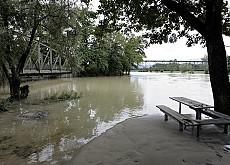
Billions needed for flood-control measures

As water levels slowly recede across Switzerland, calls for improved anti-flood measures continue to grow. The question of finance however remains unclear.
Government experts warned this weekend that an effective system of protection would require investment of several billion francs.
The government has budgeted SFr147 million ($123 million) a year for the next four years for flood-control measures.
But that is SFr100 million a year too little, according to Hans Peter Willi, head of hazard prevention at the Federal Environment Office.
Willi told the NZZ am Sonntag newspaper that “more than ten billion francs” of investment was needed over the next 20 years.
But before any investments are made, those areas at risk must first be identified. The government will therefore press ahead with the creation of a hazard map.
At present however only a third of the map has been charted, according to Roberto Loat from the environment office, who is responsible for the map. Loat says there is a lack of political will to discuss the necessary budgets.
He adds that the government will take on up to 70 per cent of the costs in order to continue with the work, which should be finished by 2011.
Water levels dropping
On Sunday the water of Lake Biel and Lake Thun receded below the danger level, but authorities say they have to wait for Lake Biel to go down even more before they can begin pumping out all the flooded houses.
The ferry on Lake Biel remained out of action, as did those on Lake Murten and Lake Neuchâtel. The ferry on Lake Brienz however resumed operation.
The sinking water level of the River Aare in Bern also enabled the flood alarm to be lifted on Sunday.
In addition electricity had returned to almost all of Delémont in canton Jura on Sunday, although power remained intermittent in certain areas such as Lake Biel.
Interrupted railway lines and roads were gradually being re-opened, although the line between Bern and Fribourg remained closed.
Authorities say that although the situation has eased, a lot remains to be done, adding that the clean-up operation will take weeks.
The environment office also jumped to the defence at the weekend of canton Bern, which had been accused by neighbouring canton Aargau of discharging too much water out of Lake Biel.
Andreas Götz, vice-director of the Environment Office, said Bern had acted according to the environment office’s guidelines, but admitted that these had at times been inexact.
swissinfo with agencies
June 8, 2007: Three people died in flooding in Huttwil and Eriswil (canton Bern).
August 21-23, 2005: Eight people died after heavy rainfall and flooding in Bern and east and central Switzerland. Many road and rail connections were cut, with the villages of Engelberg and Lauterbrunnen cut off. The damage came to SFr2.5 billion.
October 14/15, 2000: Persistent rain in canton Valais led to landslides and flooding. Sixteen people died, including 13 in the village of Gondo. The bill came to SFr500 million.
May 15, 1999: Damage estimated at SFr580 million was caused after storms in several regions, including Bern, Thun, Rheinfelden and Lake Constance.
August 15, 1997: Storms with landslides caused damage of SFr120 million in Sachseln, canton Obwalden.
September 24, 1993: After heavy rainfall, the River Saltina burst its banks, causing severe damage in the town of Brig. Two people died, with damage estimated at SFr600 million.
Summer 1987: Eight people died after storms in Poschivao and the Reuss plain in canton Uri. Damage totalled SFr1.3 billion ($1.09 billion).

In compliance with the JTI standards
More: SWI swissinfo.ch certified by the Journalism Trust Initiative



























You can find an overview of ongoing debates with our journalists here . Please join us!
If you want to start a conversation about a topic raised in this article or want to report factual errors, email us at english@swissinfo.ch.